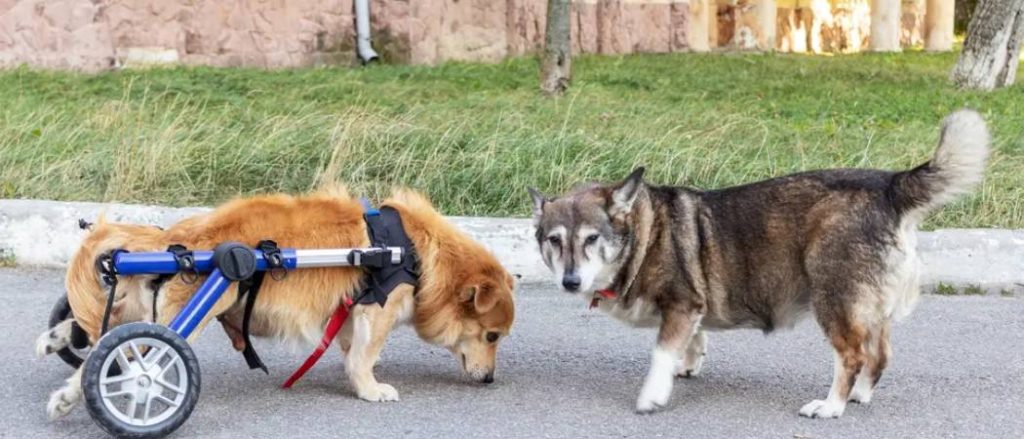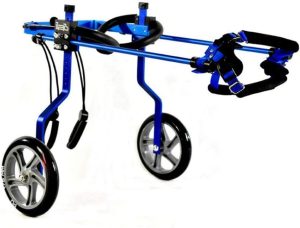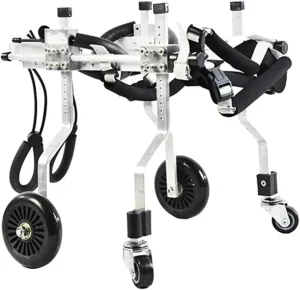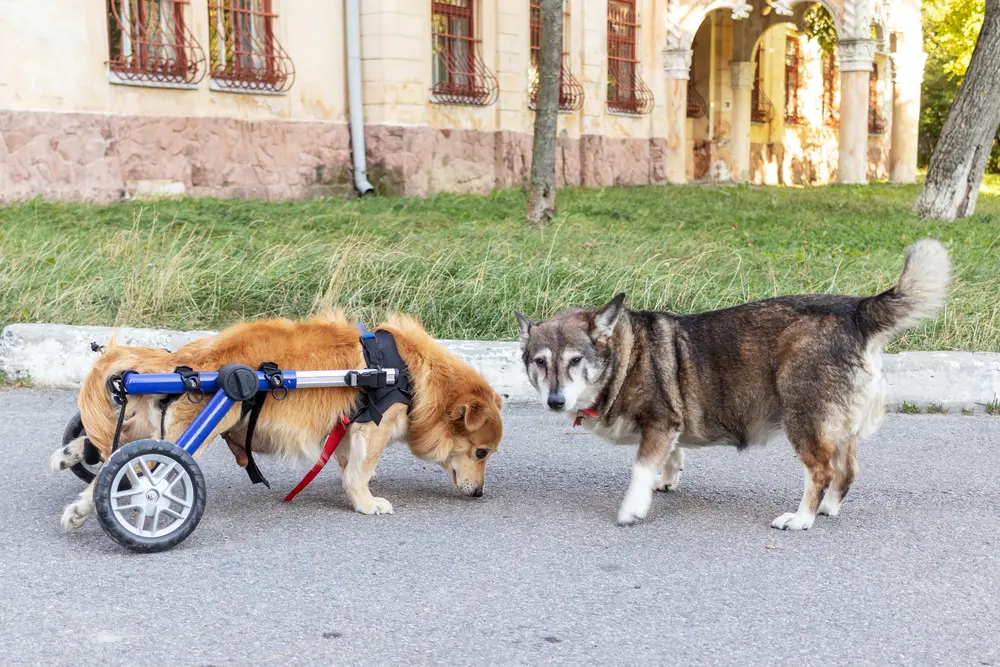As pet parents, we always want the best for our furry buddies. But even if our dear friend has lost the use of their legs, they can still live life to the fullest.
Dog wheelchairs are one answer to the problem, made possible by recent developments in veterinary medicine. The detailed guide explains everything you need to know about dog wheelchairs and how to assist your furry friend in regaining mobility.
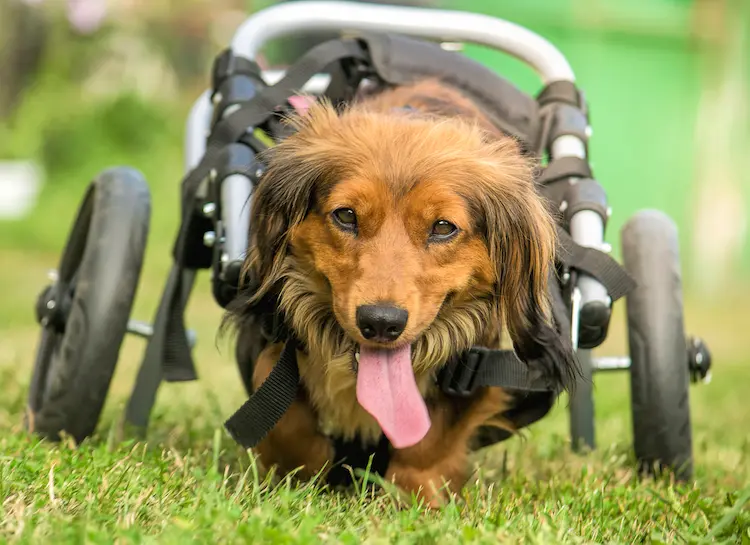
What is a Dog Wheelchair?
Dog wheelchairs, buggies, or standard carts are specialized mobility aids for dogs with leg problems such as back leg paralysis, injuries, or other mobility difficulties. It’s based on the same general design as a human wheelchair but tailored to a dog’s body and gait.
This new equipment supports the dog’s back and front legs, letting them walk around without assistance and improving their mobility.
Veterinarians often suggest and prescribe wheelchairs for pets who have trouble moving around. They are now an essential part of taking care of and rehabilitating animals.
Why Does a Dog Need a Wheelchair?
For a variety of reasons, a dog may require wheelchair support. Mobility issues such as spinal cord injuries or paralysis, degenerative diseases, nerve problems, hip dysplasia, and simply getting older are all possible causes.
A dog could use a wheelchair in the following conditions:
- Arthritis
- Amputation
- Fear or reluctance around stairs, uneven terrain, or slippery surfaces
- Weakness or muscle atrophy
- Degenerative Myelopathy or DM
- Intervertebral Disc Disease (IVDD)
- Neurological Issues
- Ligament injuries
- Surgical Recovery
- Injuries
- Improve Balance and Stability
- Difficulty in walking
Dog wheelchairs can give dogs with certain diseases a better quality of life by restoring some of their mobility.
For many reasons, a dog may require the use of a wheelchair. Although many dogs will need a wheelchair for the rest of their lives, using one temporarily while a pet recovers might be helpful.
Short-Term Uses
- When Recovering from an Injury
- As an integral aspect of their treatment plan for rehabilitation
- To alleviate pressure on painful joints (also useful for long-term usage).
- CCL tears and cruciate ligament ruptures: non-surgical treatment, sustained mobility throughout rehabilitation, and prevention of further injury by distributing weight evenly across both knees.
Long-Term Uses
- Degenerative Myelopathy
- Hind leg weakness
- Paralysis
- Cerebellar Hypoplasia
- IVDD
- Chronic osteoarthritis or severe hip dysplasia
- Wobbler’s Syndrome or CVI
You should always consult the vet if you have any reason to believe your furry pet is experiencing any of the symptoms mentioned earlier. Your dog may require more than just a wheelchair; they may also prescribe medicine or suggest surgery.
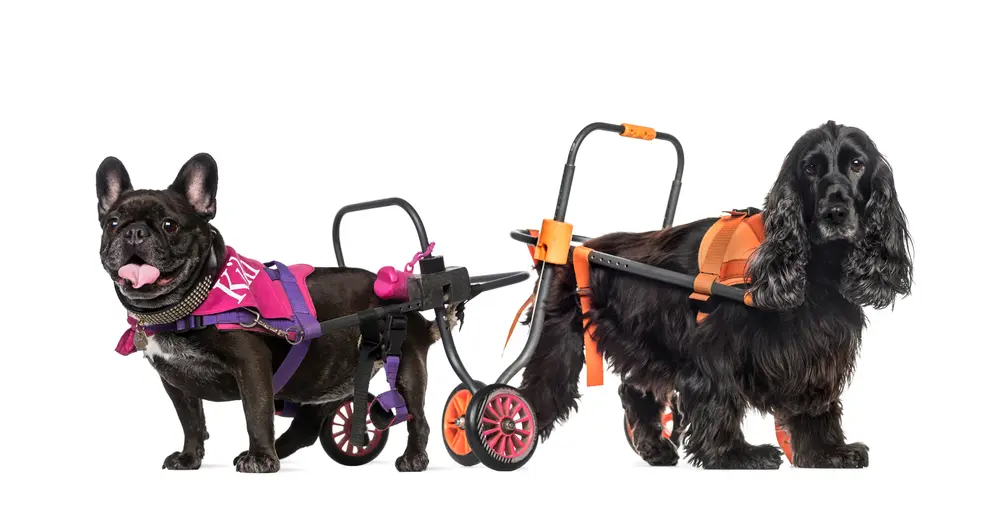
Benefits of Dog Wheelchairs
Wheelchairs are essential for dogs, cats, and other animals for stability, standing, and keeping them on their feet. They can be used temporarily during recovery or regularly to keep pets active and comfortable. Like any other supportive device, dog wheelchairs have their advantages.
Enhanced Mobility
Wheelchairs for dogs are a lifesaver for dogs who have lost the use of their back legs due to injury or illness. With their newfound independence, they may go outside and explore, play, and engage with others and their environment.
Adding Stability
Dog wheelchairs offer physical stability for dogs with chronic mobility problems. The harness system secures around the waist while the wheels aid in balancing.
Reduce Strain and Pain
By supporting the dog’s weight on the rear legs, dog wheelchairs distribute the dog’s weight evenly, thereby reducing the strain on the dog’s front legs and spinal vertebrae. It is beneficial for dogs with arthritis or spinal injuries.
Research has also found that using a mobility device such as a dog wheelchair can improve independence and reduce the strain on the body of a paralyzed dog.
Increase the Quality of Life
As with humans, mobility issues can cause anxiety, stress, and depression in dogs. A dog wheelchair can significantly help in such cases, improving their mental health and satisfaction.
Help With Speed
Dogs with movement limitations may struggle with speed as well. A dog wheelchair can help restore their active lifestyle. Wheelchair-supporting hind legs can help pets with disabilities move more quickly, enabling them to play with you again, even for walks or fetch games.
Faster Recovery
A wheelchair can help a dog rehabilitate more soon after surgery or injury by allowing it to move around safely and without placing any strain on the injured region.
Helps With Bonding and Attachment
Using a dog wheelchair lets you spend quality time outdoors with your buddy, strengthening your bond and creating unforgettable memories.
The purpose of using a wheelchair, regardless of how or when your furry friend uses one, is the same: to keep dogs active!
Types of Dog Wheelchairs
Wheelchairs for dogs can help those with mobility impairments go about more easily. Take a look at these examples of the most common ones.
Rear Support Dog Wheelchairs
The dog wheelchair for the back legs is the most common wheelchair dogs use. For dogs with weak or paralyzed back legs, these rear-leg support wheelchairs are an excellent option.
Rear-support wheelchairs have two wheels in the rear, dog support slings to raise the back legs, and two leg supports in the front. These front legs support the dog’s weight and prevent the wheelchair from tipping.
While there is some variety in the design of wheelchairs, the hind-leg wheelchairs have a set of rings that go under a dog’s pelvis and support its back legs, letting the dog stand, walk, and run like any other dog.
A support bar or “saddle” under the pet’s stomach can stop its legs from touching the ground or prevent it from doing so. Dogs that can move about would do well to have their feet flat on the floor. Such a design element can improve a dog’s chances of fully recovering from movement issues during treatment.
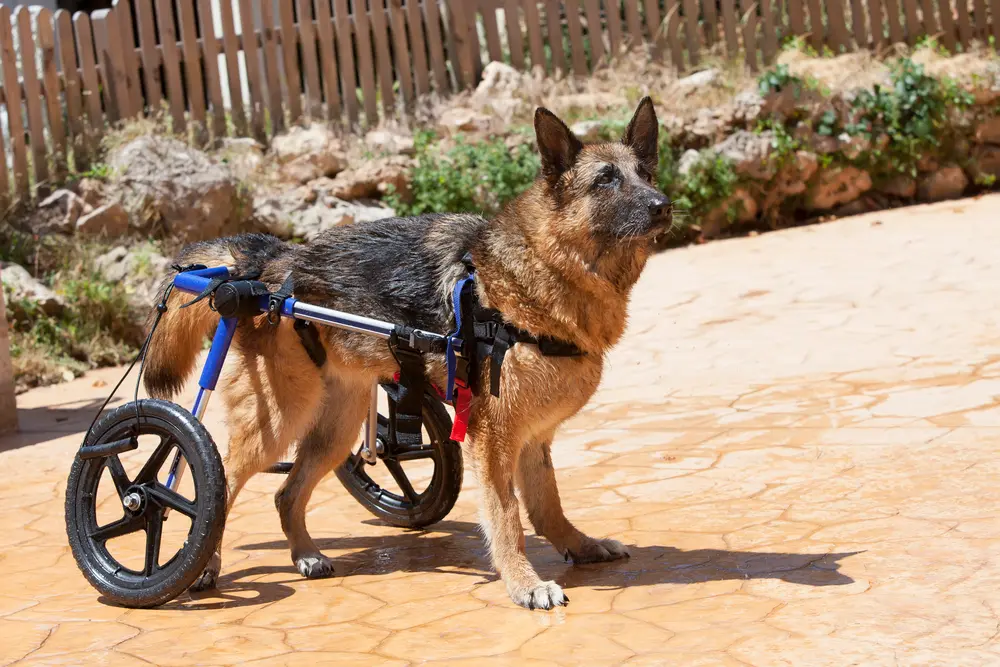
Front Support Wheelchairs
Wheelchairs with front support are appropriate for dogs with front limb impairments or amputations. While the wheels support the dog’s front legs, they enable it to navigate using its hind legs..
Front-support wheelchairs consist of two front wheels and two rear legs. The hind legs support the dog’s weight and prevent the wheelchair from toppling over.
Some versions take about 70% of the dog’s weight off the front legs. You can also install additional headrests for comfort and pain relief.
A video shows a front support wheelchair used by a small dog.
Full Support Wheelchairs
Also known as Quad wheels or full-body support wheelchairs, these are the ones with full-body support for a disabled dog. They are best for dogs with mobility issues in both their front and hind legs, such as Intervertebral Disc Disease and Degenerative Myelopathy. Your dog will still require some front leg strength to move the wheelchair, but wheelchairs like these help keep the pup steady and mobile.
These devices are the priciest on the market. Some designs have adjustable settings that allow you to provide little to maximum support for your dog.
If your dog has a spinal condition or is recovering from spinal surgery, a dog wheelchair can reduce the strain on your dog’s spine. Due to the high cost of full-body mobility aids, discussing your options with a professional before purchasing is advisable.
Adjustable Dog Wheelchairs
The frames and harnesses of these adjustable wheelchairs are adaptable, allowing them to accommodate dogs of different sizes and shapes.
Custom-Built Wheelchairs
Some dogs may have a condition or body type that makes them need a fully adjustable wheelchair, which helps to fit the needs of each dog.
As additional customizations are required, the price of pet wheelchairs will rise.
Floating Wheelchairs
Floating wheelchairs are the ideal solution for water-loving pups. These wheelchairs float and provide waterborne support for the dog, allowing them to enjoy swimming and other water sports.
A vet or a certified dog rehabilitation professional will determine the best wheelchair for your disabled dog. The mobility and comfort of your animal buddy depend on the wheelchair being correctly fitted and adjusted to them.
How Dog Wheelchairs Operate
The primary function of a dog wheelchair is to aid a dog with movement challenges by providing stability and assistance. It has the following parts that work together in operating a wheelchair.
Frames
It is the most essential part of the wheelchair. Manufacturers use aluminum and stainless steel to make the frames of a dog’s wheelchair due to their lightweight and sturdiness. The primary purpose of the frame is to connect the dog’s body to the wheels and serves as its support framework.
Wheels
The wheels on the dog wheelchair make mobility possible for animals with different leg problems. To ensure a correct fit, selecting wheels for dog wheelchairs requires consideration of the dog’s weight and the walking terrain. Some typical wheelchair wheel types for dogs are listed below.
- Foam Wheels: By a wide margin, the most common wheel type with construction done with study material These tires will never go flat and are resistant to punctures. They are also tough enough to handle any environment you throw at them.
- Air-Filled Wheels: These wheels have better suspension, can go over rougher terrain, and are usually preferred for an active dog on the run.
- Floating Wheels: These wheelchairs are the best option for pets who love water. These floating wheels are buoyant, so your dog may roll around in the water without becoming bogged down.
- Variable-Sized Wheels: Dogs with smaller body frames require wheelchairs with smaller wheels for precision and control. For larger structures or greater clearance and body support, wheelchairs designed specifically for dogs with larger wheels are available.
- Pneumatic Wheels: Pneumatic wheels, like those used on bicycles, are inflatable and provide better shock absorption and a smoother ride for the dog. They are accommodating for dogs that need to lessen the impact of their movements due to joint problems.
Harness
A dog with mobility issues may benefit from wearing a harness. It usually wraps around the dog’s chest, back, and pelvic region securely, offering support and stability while giving the dog complete freedom of movement in its legs. Various harnesses are available, such as front and back harnesses.
Straps And Fasteners
Straps and fasteners secure the wheelchair harness to the chair’s frame. You may tighten or loosen them to fit various dog sizes and shapes.
Some dog wheelchairs are equipped with elastic straps so your dog can continue using their front legs if they have mobility, motivating your dog to maintain muscle mass and mobility while utilizing a wheelchair.
Support Bars And Attachments
Depending on the type of wheelchair, support bars, a dog support sling, or attachments may support the dog’s front or hind limbs. The stirrups and the belly belt are options; only some pets need to use them. They are only required if the back legs are fully paralyzed and require elevation from the surface.
For example, rear wheels and support wheelchairs have bars that link to the frame and support the dog’s back legs. Front support wheelchairs have devices that support the dog’s front legs.
Choosing the Right Wheelchair For Dogs
Finding the ideal dog wheelchair may seem daunting. When should you consider getting your dog a wheelchair?
Fortunately, the first step is a breeze: give your dog a quick test to see if it might benefit from a wheelchair. And to evaluate your pet’s leg strength, the towel test is the ideal choice.
The Towel test
- Lift your dog’s rear end gently by placing the middle of an old towel beneath their tummy and holding both ends. Your dog should have its back flat during testing, in a “wheelbarrow” position.
- While you’re picking it up, gently nudge your dog forward.
- Depending on your dog’s behavior, you can learn how much help they need from the towel exam.
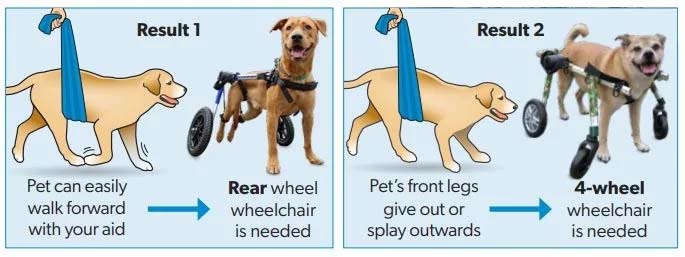
- If your dog stands firmly on its front paws and moves confidently, it is recommended to use a Rear support wheelchair.
- Even with towel support, if your dog experiences swaying, rolling into a downward dog position, stumbling, or knuckling in the front and back legs simultaneously, you will need a Full Support or Quad Wheelchair.
The video above explains the whole method of towel tests in practice.
Other Considerations When Purchasing the Ideal Dog Wheelchair
Finding a dog wheelchair that is both affordable and suitable for your pet’s requirements might be a challenge. If your veterinarian has prescribed a wheelchair for your dog, they should be able to assist you in making a suitable selection.
Let’s check out your options for wheelchair features, from wheelchair dimensions to mobility aids.
Size and Fit
Getting the right size is essential for your dog’s comfort and safety. Accurately measure your dog’s length, height, and weight, and choose a wheelchair that fits the measurements.
Small dogs as little as 2 lb Chihuahuas and as massive as 180 lb large dogs may all use the same type of wheelchair. The wheelchair’s height, length, and broadness may be modified to accommodate your four-legged pet’s wheelchair perfectly.
Material And Durability
Choose high-quality, strong, but not too heavy materials, ensuring that the wheelchair is used often and keeps your dog comfortable. Dog wheelchairs made from durable aluminum from aircraft grade are the best choice.
Style
Wheelchairs for dogs typically come in one of three styles or types: those with back wheels, those with full support (sometimes called quad wheelchairs), and those with front wheels. Make your selection depending on the areas of your dog’s body that require the most support.
Wheel Type
It can be challenging to settle on a set of wheels. Wheels with air or foam wheels?
Both types of wheels perform admirably, and each has advantages. The best wheel for your dog is the one that suits both your needs and preferences.
Adjustability
A chair that is adjustable in every way can be helpful, primarily if more than one dog uses it. Some wheelchairs have a simple mechanism that can alter the adjustments, making it easy to change the height, width, and length. It also lets you change everything to fit your pet’s needs.
Weight
Remember that your dog is already in discomfort and that purchasing a dog wheelchair is to help them walk again while ensuring their safety and comfort. A hefty dog carriage may make it difficult for the animal to maneuver. Consider something lightweight and durable.
Comfort
Your dog’s inclination to use the wheelchair depends on its comfort. The best is to search for padded harnesses, supportive slings, and soft fabrics to avoid discomfort and irritation.
Ease Of Use
Consider the wheelchair’s ease of assembly and disassembly and how easily adjustable for different terrain.
Quality and Cost
The second-last consideration is the material’s quality, sometimes proportional to the wheelchair’s price.
If you favor a budget-friendly option, be cautious not to compromise the product’s quality. There is nothing wrong with the less expensive wheelchair; however, you should consider the other essential factors. There are still quality and cost options available.
Veterinarian Approved
If you want your dog to have a wheelchair that is both useful and safe, you should look for one that veterinarians have approved.
How To Measure Your Dog For a Wheelchair
Taking accurate measurements is the first and most crucial step in finding a suitable wheelchair for your dog. Various wheelchair manufacturers have different measuring specifications. Whereas the following are the most typical. Measure Front Legs.
With your dog standing straight up, measure from the bottom of the paws to the top of the shoulder blades, right under the shoulders.
Measure the Rear Legs
If your dog can stand, measure from the floor of its pelvis to the ground. It is called the “for to groin” measurement. You can support your dog by putting your hand between its legs and ensuring its back legs are normal.
You can also measure your dog’s back legs while lying down. Tell your dog to lie down on one side. Using a measuring tape, start from the top of your dog’s thigh (at the crease) and go down to their toe pads. Don’t pull or stretch our dog’s legs while measuring.
Additional measurements that may be required are,
Torso to Abdomen Length
Measure from the middle of your dog’s front legs to the beginning of its back legs while sitting down.
Thigh Width
To determine how broad your dog’s thigh is, measure from the inside of the back leg across the larger thigh’s muscle mass. If your dog is missing a rear limb, measure the length of the leg it does have from the inside to the outside.
Weight
The size of the wheelchair frame you’ll need for your pet depends on how much your pet weighs. See which dog wheelchair fits your pet’s weight and size with the help of the wheelchair dimensions given below.
- 2 to 10 lbs. – Mini wheelchair
- 11 to 25 lbs. – Small wheelchair
- 26 to 49 lbs. – Medium wheelchair
- 50 to 69 lbs. – Medium/Large wheelchair
- 70 to 180 lbs. – Large wheelchairs
Because of their large bodies, the dachshund and the corgi each require a wheelchair of a certain length.
Introducing Dog to The Wheelchair
Also, dogs have a different intuitive understanding of moving around with an assistive mobility device attached to their body, which many pet owners need to consider.
That is why constant practice and wheelchair training becomes essential for dogs who need wheelchairs for mobility issues.
When introducing your dog to a wheelchair for the first time, it’s best to keep the experience quick, enjoyable, and stress-free. A large, open area is excellent, but the grass isn’t the best option because it might affect the performance of the wheels. The time spent in a wheelchair can gradually increase until the dog is at ease.
Splitting the session into two 10-minute chunks for the first several days might help get them started. Your dog will be able to adjust more easily and quickly in this way.
Afterming familiar with their wheelchair, they may not notice much difference, which is when you can make them move around a bit more than usual. We have mentioned some other valuable tips:
Use Common Dog Training Tricks
To avoid inducing anxiety in pets interacting with wheelchairs, and all common sense dog-training techniques apply. Allow your dog to smell it, then sensibly attach it to its body without making it resist or become fearful.
Practice With the Help of Harness
It would be best to practice placing the harness on your dog and snapping it into place so that your dog becomes accustomed to the movement and noise of the process.
Encouragement
Reward every action with a delicious treat. Training based on rewards will go a long way toward helping your furry best friend to embrace their new vehicle.
Be Watchful.
Also, look for steep inclines and obstacles or surfaces that may cause the wheels to become trapped. Trial and error is the only way to learn. As long as you keep an eye on your dog, you should be able to rescue it from a dangerous situation before it suffers a significant injury.
Many dogs adapt well to life in a wheelchair after becoming comfortable. Paralyzed pets rapidly learn that their wheelchair fulfills their natural need to move about.
When dogs use wheelchairs for the first time, even those that haven’t run in months immediately take off. It’s remarkable to see the change. As they run for the first time in months, pure happiness radiates off their face.
Introduce your dog to a wheelchair gradually, with effort and reasonable reward. It is essential to watch your dog while using the wheelchair in case the pet becomes tired or wants to go to the bathroom or take a nap.
How Long Can a Dog Stay in a Wheelchair?
Even if your dog learns to use the wheelchair easily, it isn’t perfect for prolonged periods. A dog should only use a wheelchair while on walks, playing, or socializing under close supervision.
Give your dog plenty of rest between exercise, socializing, exploration, and play.
Some owners stress that placing their pets in a wheelchair is cruel. Putting your dog in a wheelchair is not offensive at all. It allows a previously paralyzed dog to walk and run again and improves a dog’s quality of life.
It also reduces their dependence on you and makes their lives easier. They’ll be overjoyed to get a wheelchair since it will allow them to do things they used to love, like go outside and play with their friends or explore the backyard.
Tips for Caring for a Dog Wheelchair
The owner must make specific adjustments and take special precautions to ensure the wheelchair’s safety, comfort, and well-being.
Regular Inspections: Inspect the wheelchair frequently for wear and any necessary alterations. The health and safety of your dog are your top priorities.
Maintaining Hygiene: Dirt and germs can accumulate in the wheelchair if not cleaned regularly. Maintain a regular inspection schedule and quickly replace any worn or broken components.
Monitor Skin Health: Monitor your dog’s skin, especially where they will be touching the wheelchair. Keep an eye out for redness, itching, or pressure sores.
What if Nothing Helps?
If a much-loved dog can no longer walk, its owners may have to make the heartbreaking decision to put it to sleep or euthanize it. But first, we must ask, Is the dog’s life satisfying? Is the dog capable of carrying out routine tasks? Should we think about euthanizing the animal now?
The good news is that modern technology has made it possible to provide a mobility-challenged dog with a comfortable and functional environment in which to live. Learn when we should consider euthanizing our dog in our dedicated article here.
Where Can I Purchase a Wheelchair For My Dog?
Wheelchairs for dogs are available from several retail and wholesale outlets, including pet stores, veterinary clinics, and online retailers.
To guarantee the wheelchair’s quality and fit for your dog, you should buy from a respected vendor or manufacturer. Here are a few places you might look to get a wheelchair for your dog:
- Vet Centers: For dogs with mobility issues, some veterinary clinics and animal rehabilitation facilities sell standard carts and wheelchairs or recommend them. In addition, they may advise you on which wheelchair would be most suited to your dog’s condition.
- Specialized Pet Mobility Stores: You may find pet mobility devices such as dog support slings, dog wheelchairs, and supplies at pet retailers or online. These stores may carry a more extensive range of dog wheelchairs and accessories.
- Pet Retailers: There are many options for dog wheelchairs at the many internet pet supply stores. Many pet owners find it helpful to read consumer reviews before purchasing from sites like Chewy, Petco, and PetSmart.
- Online Platforms: You may find a wide selection of dog wheelchairs for sale on online marketplaces like Amazon and eBay. But before making a purchase, it is essential to research the vendor’s legitimacy.
- Custom-Built Wheelchair Providers: A customized wheelchair may be the best option if your dog has special mobility needs. Wheelchairs for dogs may be custom-made by several companies to meet your puppy’s unique requirements. A few options include Eddie’s Wheels for Pets, K9 Carts, and Walkin’ Wheels.
Finding a dog wheelchair that fits them properly and is of good enough quality to improve their mobility and well-being requires careful consideration of their demands. Always prioritize the safety and comfort of your pet when making a decision.
Dog Wheelchair Alternatives
A dog wheelchair might not be the best option for some dogs who only need a little help getting around.
When other options are readily available, a dog sling is an increasingly popular solution.
Support Sling: A Support sling, or walking sling, enables you to support the pet while it walks. It is a pouch wrapped around the dog’s body and secured with two handles. Then, when your dog walks, you may help bear its weight by holding onto it. It is notably beneficial for pets that require rehabilitation after surgery.
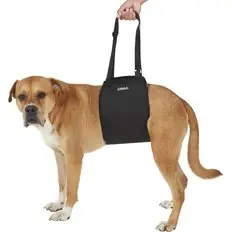
Drag Bag: A drag bag is an alternative. Wrapping your dog’s front legs and rear legs with this bag will keep them safe while running about the home. The sack protects the dog’s hind legs from scratches and other injuries. It is important to remember that the drag bag is not designed to replace the wheelchair. When the wheelchair isn’t an option, the drag bag is.

Not every pet is a good candidate for a cart, so consult your veterinarian and evaluate your pet to determine if they could benefit from a pet wheelchair, a rehab like physical therapy, surgery, or any other mobility aids.
Experiences From Pet Owners And Success Stories
Dog wheelchairs can boost a paralyzed dog’s mental and physical health by restoring some movement and giving them more independence.
A video shows at 8:45 when a small pet dog named Princess Chihuahua gets her dog wheelchair for her back legs after having a slipped disc and enjoys walking after wearing it.
A video of an 11-year-old German Shepherd dog, Jackson, wearing a Walkin Wheels dog wheelchair at 2:40 in the video shows us setting it up and his first few steps.
Sammi, a Shih Tzu, adapted swiftly to his new wheelchair, enthusiastically investigating his home and resuming his enjoyment of walks. His pet parents, the Cramptons, are overjoyed that he has regained his independence and that they no longer have to transport him. Sammi maneuvers his wheelchair with assurance, even around curbs and corners.
Zip was a young dog who had an accident that immobilized his hind legs due to a spinal injury. The pet owner, Sue, got him a special wheelchair built for dogs. His former excitement for life returned, and he has since excelled in agility training, earning a particular spot in a local dog competition.
As the video shows, Zip hops over each fence even after removing the poles, much to the crowd’s amusement.
After years of good health, Daisy, a GSD, was diagnosed with DM (Degenerative myelopathy). After much debate, the owners decided to try a dog wheelchair when her mobility issues became problematic. She felt more self-assured and content after getting an entire support dog wheelchair.
The video provides a high-level summary of her progress.
Another inspirational video of a Quadriplegic Beagle regaining her full mobility after using a dog wheelchair for her back leg.
These real-life stories show how the introduction of dog wheelchairs improved the quality of life for these four-legged friends.
Conclusion
Dogs with mobility issues can benefit significantly from dog wheelchairs. These wheelchairs allow for more freedom of movement, less discomfort, and a more intimate relationship with your pet. You can pick the best wheelchair for your dog by considering its size, shape, mobility, and comfort.
Undoubtedly, dog wheelchairs restore your furry dog’s mobility, so they may resume running, playing, and exploring with you and other dog companions, perhaps increasing their quality of life. Even the veterinary sector now devotes significant attention to the scientific study of dog wheelchairs.
It’s important to remember that an effortless transition from your dog to a wheelchair requires a gradual introduction and lots of positive reinforcement. Your pet dog may live a healthy, happy life and rediscover the pleasure of mobility with your help. Since our dogs want the best for us, it only makes sense that we provide the same for them.
